
The Lamiaceae or Labiatae are a family of flowering plants commonly known as the mint, deadnettle, or sage family. Many of the plants are aromatic in all parts and include widely used culinary herbs like basil, mint, rosemary, sage, savory, marjoram, oregano, hyssop, thyme, lavender, and perilla, as well as other medicinal herbs such as catnip, salvia, bee balm, wild dagga, and oriental motherwort. Some species are shrubs, trees, or, rarely, vines. Many members of the family are widely cultivated, not only for their aromatic qualities, but also their ease of cultivation, since they are readily propagated by stem cuttings. Besides those grown for their edible leaves, some are grown for decorative foliage. Others are grown for seed, such as Salvia hispanica (chia), or for their edible tubers, such as Plectranthus edulis, Plectranthus esculentus, Plectranthus rotundifolius, and Stachys affinis. Many are also grown ornamentally, notably coleus, Plectranthus, and many Salvia species and hybrids.
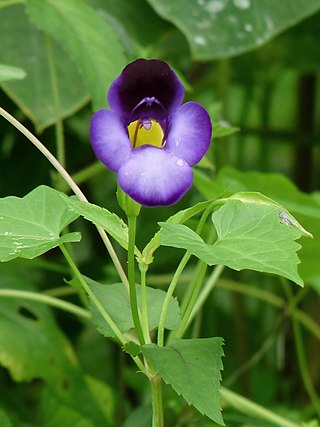
Torenia is a genus of plants now classified in the family Linderniaceae. Torenia has also been classified in the figwort family Scrophulariaceae. Often called wishbone flowers, bluewings; in Hawaii nanioola'a or ola'a beauty, some species are grown as garden plants. Many F1 and F2 Torenia hybrids have been hybridized in the last 30 years. Colors can range from white with yellow throats to violet, blue, cobalt, lavender and purple.

Linderniaceae is a family of flowering plants in the order Lamiales, which consists of about 25 genera and 265 species occurring worldwide. Vandellia micrantha is eaten in Laos, but tastes bitter. Best known are the wishbone flowers Torenia fournieri and Torenia thouarsii, which are used as bedding plants, especially in the tropics. Micranthemum is sold as an aquarium plant when it is called 'baby tears'.
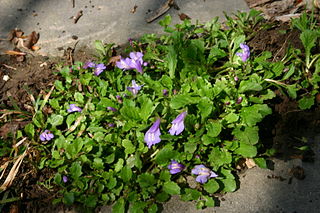
Mazus is a genus of low-growing perennial plants. It has been placed in various plant families including Phrymaceae, Scrophulariaceae, and recently in the family Mazaceae. Consisting of around 40 species, this genus is generally found in damp habitats in lowland or mountain regions of China, Japan, India, Southeast Asia, Australia and New Zealand.
Brandisia is a genus of flowering plants in the family Orobanchaceae.
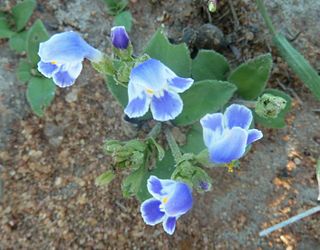
Craterostigma is a genus of shrub-like flowering plants in the family Linderniaceae, found in Africa, Madagascar, Socotra, the Arabian Peninsula, the Indian Subcontinent, Sri Lanka, China, Southeast Asia and Java. The best studied species is the resurrection plant Craterostigma plantagineum, known for its unique drought tolerance.

Adenosma is a genus of flowering plants belonging to the family Plantaginaceae.

Bonnaya is a genus of flowering plants belonging to the family Linderniaceae.
Micranthemum is a genus of flowering plants belonging to the family Linderniaceae.
Sopubia is a genus of flowering plants belonging to the family Orobanchaceae.
Scolophyllum is a genus of flowering plants belonging to the family Linderniaceae.
Hartliella is a genus of flowering plants belonging to the family Linderniaceae.
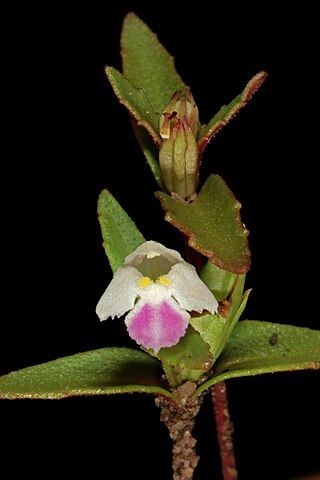
Linderniella is a genus of flowering plants belonging to the family Linderniaceae.
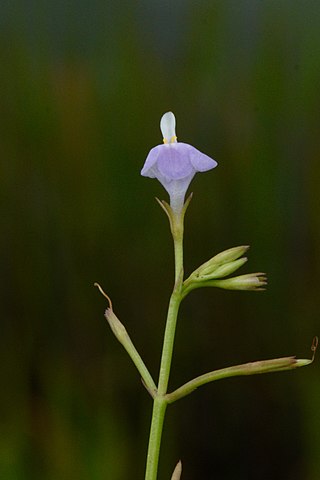
Bonnaya antipoda is a herbaceous perennial plant belonging to Linderniaceae family. It is native to tropical and sub-tropical Asia and Australia.









